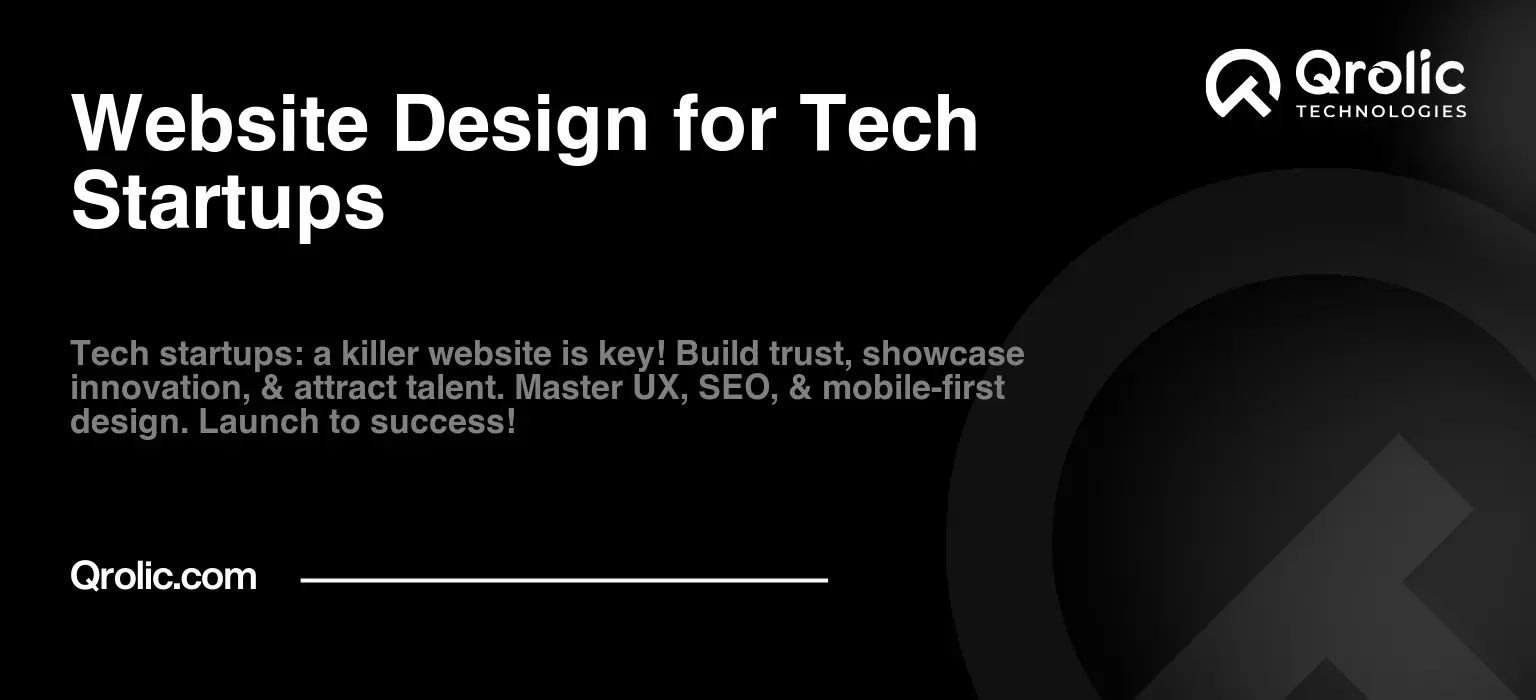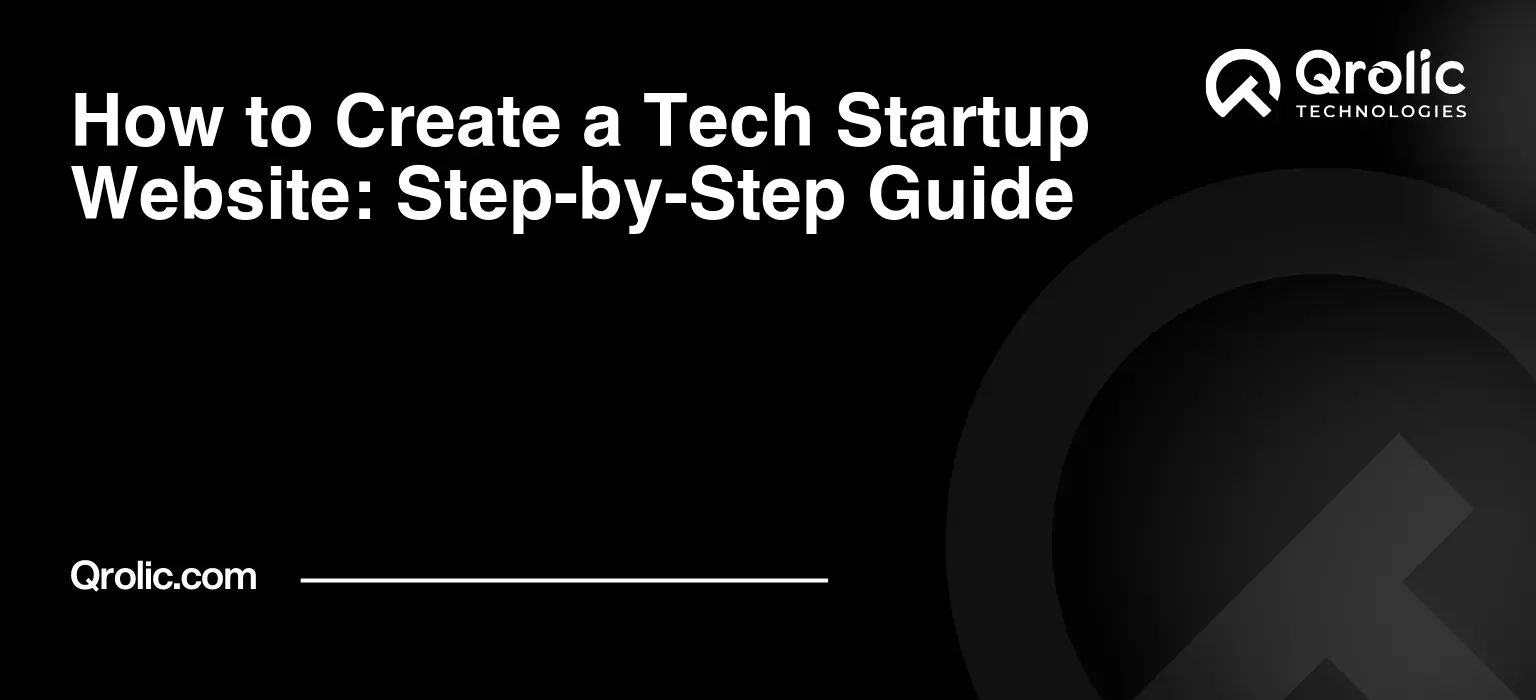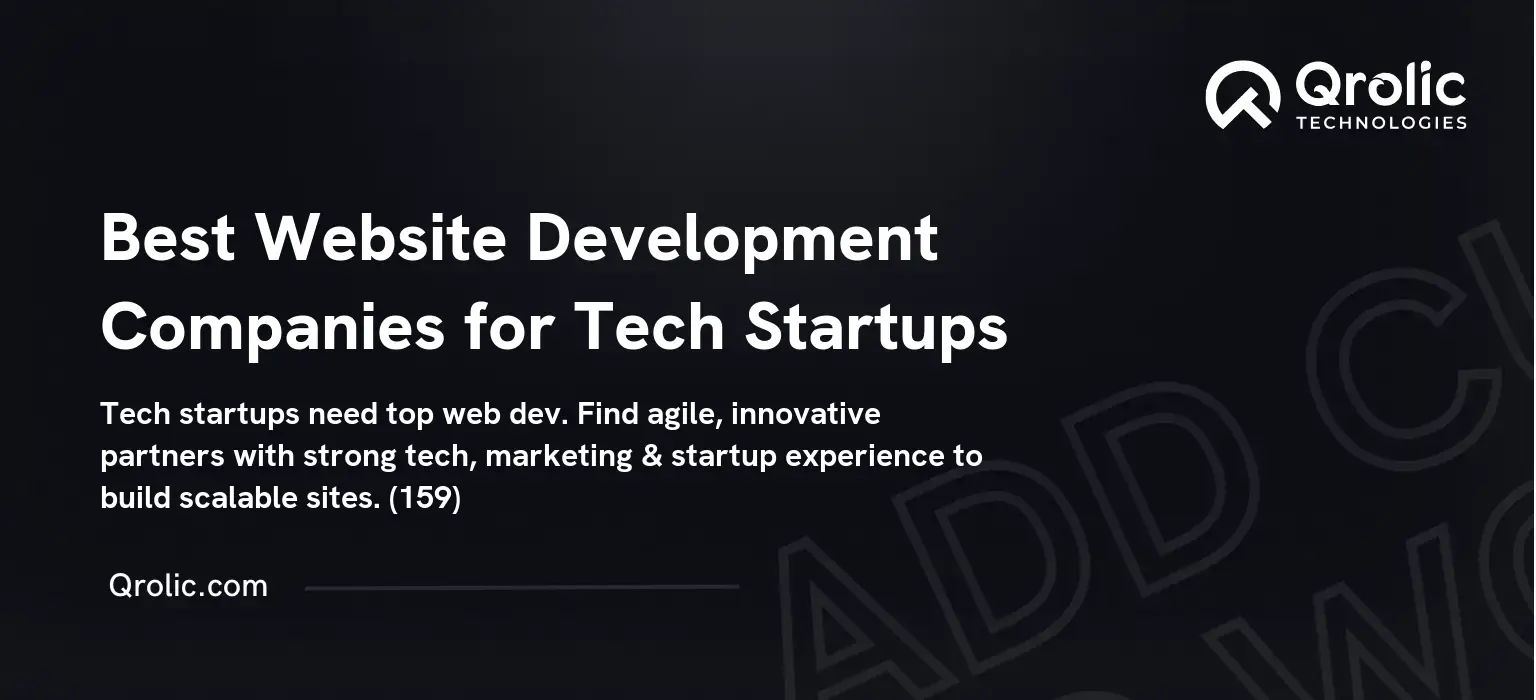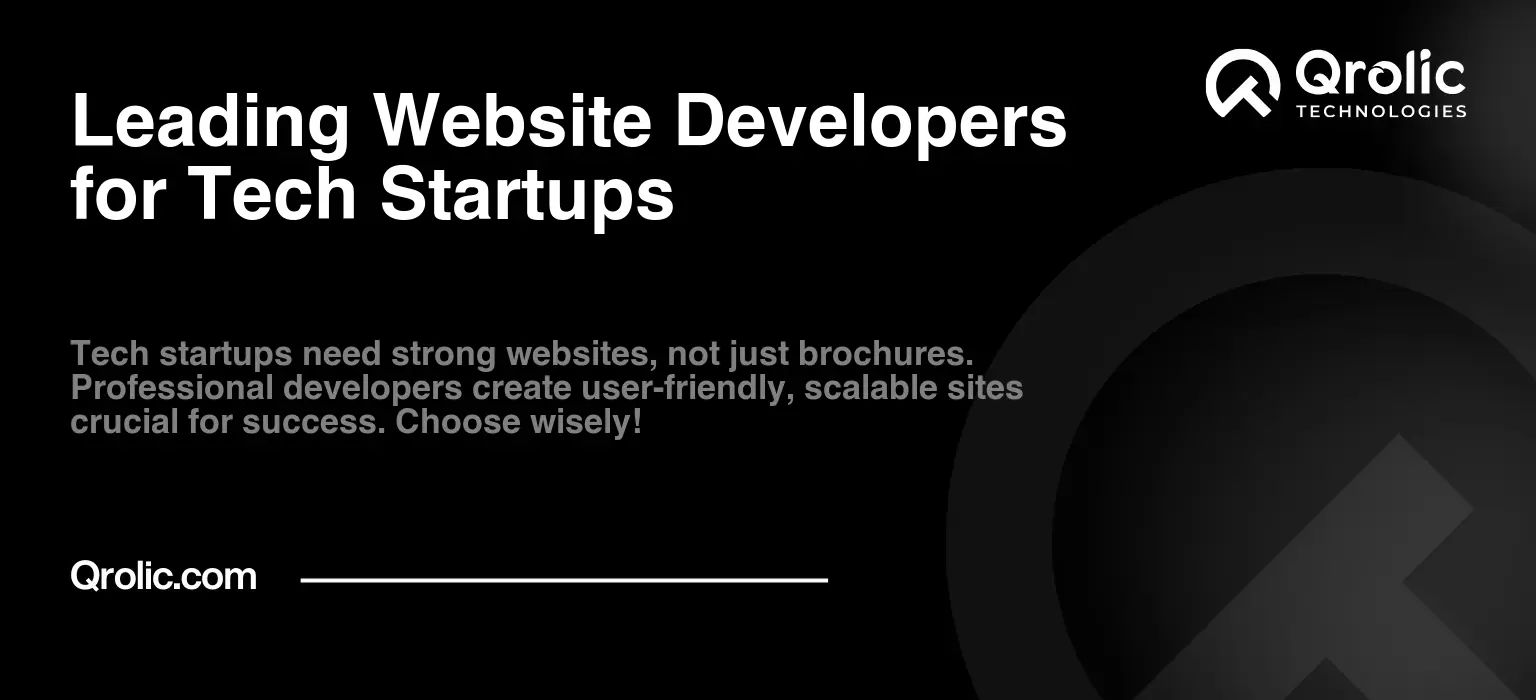In today’s hyper-competitive landscape, a compelling online presence is no longer optional for tech startups – it’s a necessity. Your website is often the first interaction potential customers, investors, and partners have with your brand. It’s your digital storefront, your 24/7 sales pitch, and your opportunity to make a lasting impression. This comprehensive guide delves deep into the nuances of website design for tech startups, covering everything from fundamental principles to cutting-edge strategies.
Quick Summary:
- Your website builds trust, attracts leads, and talent.
- Design for users, mobile, and search engines.
- Avoid common mistakes and track website performance.
Table of Contents
- Why Your Tech Startup Needs a Killer Website
- Key Elements of Effective Tech Startup Website Design
- 1. Understanding Your Target Audience
- 2. Defining Your Website Goals
- 3. Information Architecture and Navigation
- 4. Visual Design and Branding
- 5. Content Strategy and Messaging
- 6. Mobile-First Design and Responsiveness
- 7. User Experience (UX) and User Interface (UI)
- 8. Search Engine Optimization (SEO) for Tech Startups
- 9. Analytics and Tracking
- 10. Security and Performance
- Examples of Inspiring Tech Startup Websites
- Common Mistakes to Avoid in Tech Startup Website Design
- The Future of Website Design for Tech Startups
- Building Your Tech Startup Website: DIY vs. Hiring an Agency
- DIY Website Builders
- Hiring a Website Design Agency
- Qrolic Technologies: Your Partner in Innovative Web Development
- Conclusion: Your Website – Your Launchpad for Success
Why Your Tech Startup Needs a Killer Website
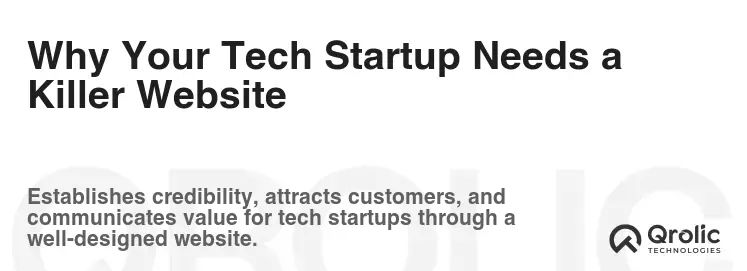
Your website isn’t just a pretty face; it’s a powerful engine driving growth and establishing credibility. Here’s why investing in exceptional website design is paramount for tech startups:
- Building Trust and Credibility: A professionally designed website instantly conveys trustworthiness and legitimacy. In the tech world, where innovation is key, a polished online presence assures visitors that you’re a serious player.
- Generating Leads and Driving Sales: Your website acts as a lead generation machine. By strategically incorporating calls to action (CTAs), compelling content, and user-friendly navigation, you can convert visitors into qualified leads and paying customers.
- Showcasing Your Innovation: Tech startups are built on groundbreaking ideas. Your website provides the platform to showcase your unique technology, explain its benefits, and demonstrate its real-world applications.
- Attracting Talent: Top talent seeks out innovative and forward-thinking companies. A modern, engaging website demonstrates your commitment to technology and attracts talented individuals who want to be part of something special.
- Communicating Your Brand Story: Your website is the perfect place to tell your brand story, articulate your mission, and connect with your audience on an emotional level.
- Establishing Market Authority: Consistently publishing valuable content on your website, such as blog posts, case studies, and white papers, establishes you as a thought leader in your industry and builds authority.
- Improving Search Engine Visibility (SEO): A well-optimized website ranks higher in search engine results, making it easier for potential customers to find you online. Effective tech startup website design incorporates SEO best practices to maximize visibility.
Key Elements of Effective Tech Startup Website Design
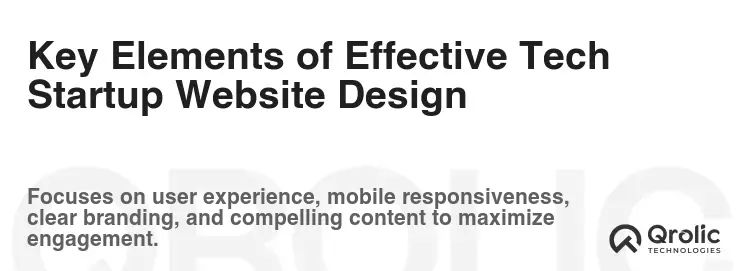
Creating a website that resonates with your target audience and achieves your business goals requires careful planning and execution. Here are the essential elements to consider:
1. Understanding Your Target Audience
Before you even start designing, you need to deeply understand your target audience. Who are you trying to reach? What are their needs, pain points, and aspirations? What are they looking for in a tech solution?
- Conduct thorough market research: Use surveys, interviews, and focus groups to gather insights into your target audience’s demographics, psychographics, and online behavior.
- Create detailed user personas: Develop fictional representations of your ideal customers, outlining their characteristics, goals, and challenges.
- Analyze competitor websites: Identify what your competitors are doing well (and not so well) and use this information to inform your own design strategy.
2. Defining Your Website Goals
What do you want your website to achieve? Are you primarily focused on generating leads, driving sales, building brand awareness, or attracting investors?
- Set SMART goals: Define specific, measurable, achievable, relevant, and time-bound goals for your website.
- Prioritize your goals: Identify your most important goals and focus your design efforts on achieving them.
- Track your progress: Use analytics tools to monitor your website’s performance and make adjustments as needed.
3. Information Architecture and Navigation
Your website’s information architecture (IA) is the blueprint for how your content is organized and structured. A well-defined IA makes it easy for visitors to find what they’re looking for, improving their user experience and increasing engagement.
- Create a clear and logical site map: Outline the main pages of your website and their relationships to each other.
- Use intuitive navigation: Make sure your navigation menu is easy to understand and use, with clear labels and a consistent structure.
- Implement breadcrumbs: Provide breadcrumb navigation to help users understand their location within the website.
- Optimize internal linking: Link to relevant pages within your website to improve SEO and guide users through your content.
4. Visual Design and Branding
Your website’s visual design should reflect your brand identity and create a positive and memorable experience for visitors.
- Choose a visually appealing design: Use high-quality images, videos, and graphics to capture attention and convey your message effectively.
- Maintain a consistent brand identity: Use your brand colors, fonts, and logo consistently throughout your website.
- Embrace minimalism: Avoid clutter and unnecessary elements that can distract visitors.
- Prioritize readability: Use clear and legible fonts, appropriate spacing, and sufficient contrast to make your content easy to read.
5. Content Strategy and Messaging
Your website’s content is the heart and soul of your online presence. It’s what attracts visitors, engages them, and ultimately convinces them to take action.
- Create compelling and informative content: Write clear, concise, and engaging content that addresses your target audience’s needs and interests.
- Focus on benefits, not just features: Explain how your technology solves problems and improves people’s lives.
- Use strong calls to action (CTAs): Guide visitors towards desired actions, such as signing up for a demo, requesting a quote, or making a purchase.
- Develop a content calendar: Plan and schedule your content creation efforts to ensure a consistent stream of fresh and relevant content.
- Optimize your content for SEO: Use relevant keywords, meta descriptions, and header tags to improve your search engine rankings.
6. Mobile-First Design and Responsiveness
In today’s mobile-dominated world, it’s crucial to design your website with mobile devices in mind.
- Adopt a mobile-first approach: Design your website for mobile devices first, then adapt it for larger screens.
- Ensure responsiveness: Make sure your website adapts seamlessly to different screen sizes and devices.
- Optimize for mobile performance: Minimize page load times and optimize images for mobile devices.
- Test on different devices: Test your website on a variety of mobile devices to ensure a consistent and user-friendly experience.
7. User Experience (UX) and User Interface (UI)
User experience (UX) refers to the overall experience a user has while interacting with your website. User interface (UI) refers to the visual design and interactive elements of your website.
- Prioritize user-centered design: Design your website with the user in mind, focusing on their needs and goals.
- Conduct usability testing: Test your website with real users to identify areas for improvement.
- Simplify the user journey: Make it easy for users to find what they’re looking for and complete desired actions.
- Use clear and concise language: Avoid jargon and technical terms that may confuse users.
- Provide helpful feedback: Give users clear feedback on their actions, such as form submissions and error messages.
8. Search Engine Optimization (SEO) for Tech Startups
SEO is the process of optimizing your website to rank higher in search engine results. This is crucial for attracting organic traffic and reaching potential customers.
- Conduct keyword research: Identify the keywords your target audience is using to search for your products or services.
- Optimize your website content: Use relevant keywords in your page titles, meta descriptions, header tags, and body text.
- Build high-quality backlinks: Earn links from other reputable websites in your industry.
- Optimize your website’s technical SEO: Ensure your website is mobile-friendly, loads quickly, and has a clear site map.
- Track your SEO performance: Use analytics tools to monitor your website’s search engine rankings and traffic. Tech startup website design requires a strategic SEO approach.
9. Analytics and Tracking
Tracking your website’s performance is essential for understanding what’s working and what’s not.
- Install Google Analytics: Use Google Analytics to track your website’s traffic, user behavior, and conversions.
- Set up goal tracking: Define specific goals in Google Analytics to track your website’s progress towards achieving your business objectives.
- Monitor your website’s performance regularly: Analyze your website’s data to identify areas for improvement.
- Use A/B testing: Experiment with different design elements and content to see what resonates best with your audience.
10. Security and Performance
Ensuring your website is secure and performs well is crucial for protecting your users and providing a positive experience.
- Install an SSL certificate: Protect your website with an SSL certificate to encrypt data transmitted between your website and users’ browsers.
- Use a secure hosting provider: Choose a hosting provider that offers robust security measures.
- Keep your website software up to date: Regularly update your website’s software to patch security vulnerabilities.
- Optimize your website’s performance: Minimize page load times, optimize images, and use a content delivery network (CDN).
Examples of Inspiring Tech Startup Websites
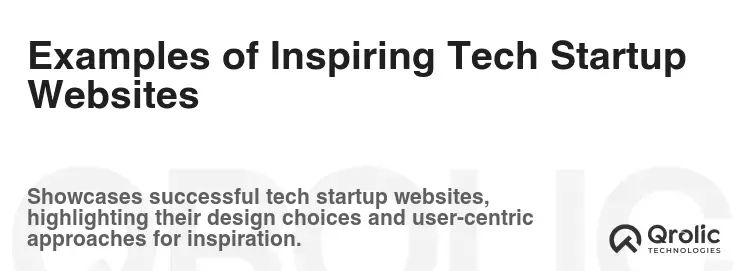
To spark your imagination and provide real-world inspiration, here are some examples of tech startup websites that are doing it right:
- [Insert Example 1 – e.g., Stripe]: Briefly describe why this website is effective (e.g., clear value proposition, minimalist design, strong brand identity).
- [Insert Example 2 – e.g., Notion]: Briefly describe why this website is effective (e.g., engaging visuals, user-friendly interface, showcases product benefits).
- [Insert Example 3 – e.g., Figma]: Briefly describe why this website is effective (e.g., interactive demos, strong social proof, clear calls to action).
(Replace the bracketed placeholders above with actual examples of tech startup websites. Briefly explain why each example is effective in terms of design, user experience, and content.)
Common Mistakes to Avoid in Tech Startup Website Design
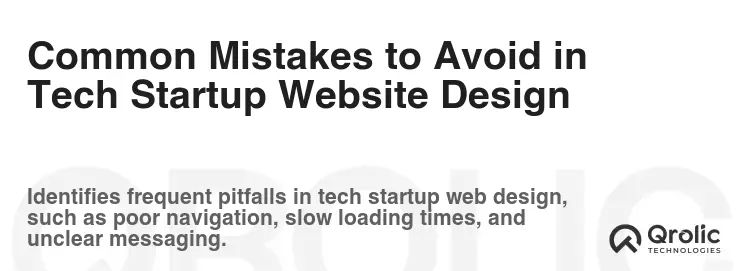
Even with the best intentions, it’s easy to make mistakes when designing a website for your tech startup. Here are some common pitfalls to avoid:
- Overcomplicating the Design: Keep it simple and focus on clarity.
- Ignoring Mobile Users: Ensure your website is fully responsive and optimized for mobile devices.
- Using Jargon and Technical Terms: Speak your audience’s language and avoid technical terms that may confuse them.
- Neglecting SEO: Optimize your website for search engines to attract organic traffic.
- Failing to Track Analytics: Monitor your website’s performance to identify areas for improvement.
- Slow Loading Times: Optimize images and use a CDN to improve page load times.
- Poor User Experience (UX): Prioritize user-centered design and conduct usability testing.
- Lack of Clear Calls to Action: Guide visitors towards desired actions with clear and compelling CTAs.
- Inconsistent Branding: Maintain a consistent brand identity throughout your website.
- Ignoring Website Security: Protect your website with an SSL certificate and use a secure hosting provider.
The Future of Website Design for Tech Startups

The world of website design is constantly evolving, and tech startups need to stay ahead of the curve to remain competitive. Here are some emerging trends to watch:
- Artificial Intelligence (AI): AI is being used to personalize website experiences, automate tasks, and provide intelligent customer support.
- Virtual Reality (VR) and Augmented Reality (AR): VR and AR are being used to create immersive and interactive website experiences.
- Voice Search Optimization: Optimizing your website for voice search is becoming increasingly important as voice assistants like Siri and Alexa become more popular.
- Personalization: Delivering personalized content and experiences based on user data is becoming increasingly important.
- Accessibility: Ensuring your website is accessible to users with disabilities is not only ethical but also good for business.
Building Your Tech Startup Website: DIY vs. Hiring an Agency
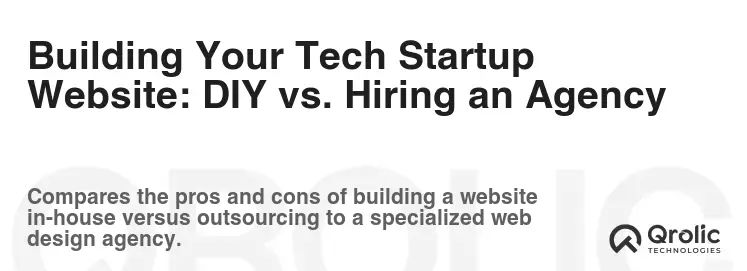
You have two main options when it comes to building your tech startup website: Do-It-Yourself (DIY) or hiring a professional website design agency. Each approach has its own advantages and disadvantages.
DIY Website Builders
Pros:
- Cost-effective: DIY website builders are generally more affordable than hiring an agency.
- Easy to use: Many DIY website builders offer drag-and-drop interfaces that make it easy to create a website without any coding knowledge.
- Quick turnaround: You can launch a website quickly using a DIY website builder.
Cons:
- Limited customization: DIY website builders often offer limited customization options.
- Lack of expertise: You may not have the expertise to create a truly professional and effective website.
- Time commitment: Building a website yourself can be time-consuming, especially if you’re not familiar with the process.
- Scalability issues: Some DIY website builders may not be suitable for growing businesses.
Hiring a Website Design Agency
Pros:
- Expertise and experience: Website design agencies have the expertise and experience to create a high-quality, effective website.
- Custom design: Agencies can create a custom design that reflects your brand identity and meets your specific needs.
- Time savings: Hiring an agency frees up your time to focus on other aspects of your business.
- Scalability: Agencies can create a website that can scale as your business grows.
- SEO Expertise: Agencies like Qrolic have the resources to ensure your website ranks highly on search engines.
Cons:
- Higher cost: Hiring an agency is generally more expensive than using a DIY website builder.
- Longer turnaround: The process of working with an agency can take longer than building a website yourself.
Which option is right for you?
The best option for you depends on your budget, technical skills, and time commitment. If you have a limited budget and are comfortable with technology, a DIY website builder may be a good option. However, if you want a truly professional and effective website, hiring a website design agency is generally the best choice.
Qrolic Technologies: Your Partner in Innovative Web Development

At Qrolic Technologies (https://qrolic.com/), we understand the unique challenges and opportunities that tech startups face. We’re not just a website design agency; we’re your strategic partner in building a digital presence that drives growth and achieves your business goals. We specialize in innovative web development and are dedicated to crafting websites that are not only visually stunning but also highly functional, user-friendly, and optimized for search engines.
Why Choose Qrolic?
- Deep understanding of the tech industry: We have a proven track record of working with tech startups across various industries.
- Custom design solutions: We create custom website designs that reflect your brand identity and meet your specific needs.
- User-centered approach: We prioritize user experience (UX) and user interface (UI) to ensure your website is easy to use and engaging.
- SEO expertise: We optimize your website for search engines to attract organic traffic and improve your online visibility.
- Scalable solutions: We build websites that can scale as your business grows.
- Dedicated support: We provide ongoing support and maintenance to ensure your website is always up-to-date and performing optimally.
Our Services for Tech Startups:
- Website Design and Development: We create custom websites that are tailored to your specific needs and goals.
- E-commerce Development: We build online stores that are easy to use and optimized for conversions.
- Mobile App Development: We develop mobile apps for iOS and Android devices.
- SEO and Digital Marketing: We help you improve your search engine rankings and drive traffic to your website.
- Content Creation: We create compelling and informative content that engages your target audience.
Ready to launch your tech startup into the digital realm? Contact Qrolic Technologies today for a free consultation. Let us help you build a website that converts visitors into customers and propels your business to success.
Conclusion: Your Website – Your Launchpad for Success
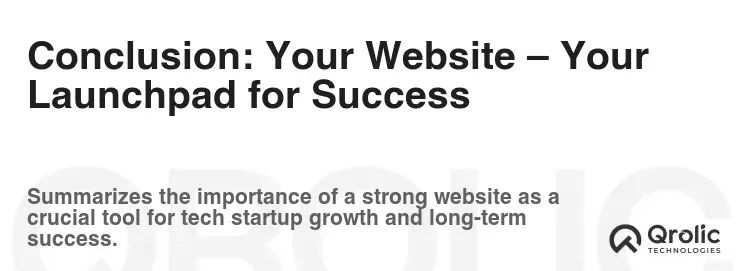
Your website is more than just a digital brochure; it’s a critical tool for building your brand, generating leads, and driving sales. By investing in effective website design, you can create a powerful online presence that attracts customers, investors, and talent.
Remember to focus on your target audience, define your website goals, create a clear and logical information architecture, prioritize user experience, and optimize for search engines. Avoid common mistakes and stay ahead of the curve by embracing emerging trends.
Whether you choose to build your website yourself or hire a professional agency like Qrolic Technologies, make sure you invest the time and resources necessary to create a website that truly represents your brand and achieves your business objectives. Your website is your launchpad for success – make it count!
